Abstract
Maize-peanut strip intercropping is an important method to solve the contradiction between grain and oil land competition, and achieve stable grain and oil production. However, there are no research reports on the selection and matching of agricultural machinery for such planting patterns at home and abroad. Therefore, this article takes the Henan Province of China as an example to carry out a study. The main content of this study is to determine the pattern of maize-peanut strip intercropping and screen the agricultural machinery from the perspective of deep integration of agricultural machinery and agronomy. A new strip intercropping pattern consisting of four rows of maize and two ridges (four rows) of peanut was determined. A series of operating machineries suitable for this planting pattern were selected for the needs of mechanized sowing, field spraying, and harvesting. Field experiments were conducted to further verify the applicability and reliability of the determined planting pattern and operating machinery. The yield of 4-4 strip intercropping is slightly lower than that of monocropping maize, but the yield of peanut per mu can be increased by 105.2 kg. Moreover, the yield per mu of 4-4 strip intercropping is about 40% of that of monocropping peanut. This study can effectively compensate for the lack of research on the screening of agricultural machinery for maize-peanut strip intercropping at home and abroad. It also can provide beneficial exploration for the full mechanized production of maize and peanut under this planting pattern, and provide reference for the mechanized production of other crops strip intercropping.
1. Introduction
China is an agricultural country with more people and less arable land. In recent years, with the growth of population, the improvement of people’s living standards and the development of animal husbandry, has resulted in an increased demand for grain and oil crops, such as maize (Zea mays L.) and peanut (Arachis hypogea L.). However, China’s arable land area is limited, and maize and peanut are planted in the same season; there is a contradiction between them. How to achieve the unity of high output and sustainability is a major challenge for maize and peanut production. In particular, how to achieve a double harvest of maize and peanut while avoiding the conflict between competing for land has become an urgent problem in current agricultural production.
Intercropping is the essence of traditional Chinese agriculture, which has a long history [1]. As early as 2000 years ago, there were records in the ancient Chinese agricultural book “The Book of Fanshengzhi”. Intercropping maize and peanut is one of the main types of intercropping agriculture in China [2]. It has been practiced in China’s agricultural production in the 1950s and 1960s, and has been popularized in India [3], Sri Lanka [4], Iran [5], Indonesia [6], Japan [7], Bangladesh [8], Türkiye [9], Congo [10], Cameroon [11], Benin [12], Ghana [13], Nigeria [14], Egypt [15], Zimbabwe [16], the United States [17], Australia [18] and other countries.
The technology of intercropping maize and peanut is an important measure to solve the contradiction between grain and oil competing for arable land, which is of great significance for ensuring national grain and oil security, promoting sustainable agricultural development, and increasing farmers’ income. However, current research reports on intercropping maize and peanut are mostly focused on agronomic aspects, such as comparison of planting benefits, effects of photosynthetic characteristics, and promotion of fertilizer utilization [2,3,4,5,6,7,8,9,10,11,12,13,14,15,16,17,18,19,20]. There are few reports on mechanized production. Moreover, the existing planting patterns are complex and not conducive to mechanized operations. The inter-annual crop rotation is also relatively difficult and does not meet the green and sustainable development goals of modern agriculture.
In recent years, in order to meet the structural adjustment goals of China’s planting industry and the demand for coordinated development of grain and oil, a maize-peanut strip intercropping technology has been proposed. This technology focuses on facilitating mechanized operations and reducing plant spacing to ensure crop density. However, the research on determining the best planting pattern and screening agricultural machinery is still incomplete. Therefore, this work takes Henan Province as the research object, which is the main area for peanut and maize production in China. Through the deep integration of agricultural machinery and agronomy, the determination of the maize-peanut strip intercropping pattern and screening of agricultural machinery will be carried out. This study can provide support for the large-scale popularization and application of maize-peanut strip intercropping technology.
2. Present Situation of Maize and Peanut in China
2.1. Situation of the Whole Country
2.1.1. Planting Situation
Maize is a major staple food crop in China, as well as an important feed and industrial raw material. Peanut is an important oil crop, which plays an important role in ensuring the supply of edible vegetable oil.
According to statistics from the Food and Agriculture Organization of the United Nations (FAO), in 2021, China’s maize harvested area ranked first in the world, accounting for 21.1% of the world’s total area. The maize yield ranks second in the world, accounting for about 22.5% of the world’s total yield. The peanut harvested area of China ranks second in the world, accounting for approximately 14.5% of the world’s total area. The peanut yield ranks first in the world, accounting for 34.0% of the world’s total yield. As shown in Figure 1, the sown area and total yield of maize and peanut in China form the reform, opening up from 1978 to 2021.
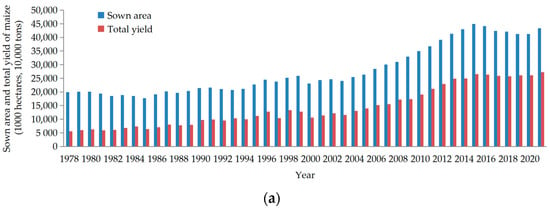
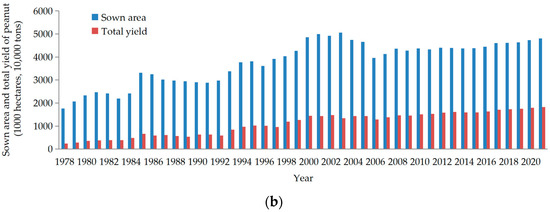
Figure 1.
Area and yield of maize and peanut: (a) Maize; (b) Peanut. Note: the data are obtained from The China Rural Statistical Yearbook.
As can be seen from Figure 1a, the sown area of maize is basically maintained at around 20 million hectares before 1995. By 1999, the area had increased to 25 million hectares, and then began to decrease. Since 2003, there has been an increasing trend year by year, which reached a peak in 2015. In the following years, affected by the structural reform policies of the national planting industry, the area has decreased, but it shows a growth trend in 2021. The total yield of maize was less than 100 million tons before 1995, and it exceeded 200 million tons in 2011. Although the sown area in 2021 was not the largest, its total yield was the highest. The average yield was 6.3 tons/hectares, which was 2.3 times the average yield in 1978.
It can be seen from Figure 1b that the peanut sown area is in a fluctuating state. In 1998, the area exceeded four million hectares and showed a trend of annual growth, reaching a peak in 2003. In the following years, it decreased somewhat, but remained basically within the range of four to five million hectares. Before 1995, the yield of peanut showed an overall growth trend, but both were less than 10 million tons. It exceeded 15 million tons in 2010 and 18 million tons in 2021. The average yield in 2021 was 3.8 tons/hectares, which was 2.8 times the average yield in 1978.
2.1.2. Situation of Mechanized Production
Mechanized operation is the foundation for achieving high quality and efficient production of maize and peanut, which can significantly increase productivity and reduce labor intensity [21,22]. In recent years, with the progress of science and technology and social development, the mechanization rate of maize and peanut production in China has significantly improved. In 2021, the comprehensive rate of mechanized plowing, sowing and harvesting of maize in China has reached 90%, which was 38 percentage points higher than that in 2008. Among them, the mechanization rate of plowing exceeded 98% and the mechanization rate of sowing exceeded 90%. Additionally, the mechanization rate of harvesting approaches 80%. The comprehensive rate of the mechanized production of peanut exceeded 65%, which was nearly 30 percentage points higher than in 2008. Among them, the mechanization rate of plowing exceeded 80%, and the mechanization rate of sowing and harvesting were around 60% and 50%, respectively. Figure 2 shows the comprehensive rate of mechanized production of maize and peanut in China in the past 10 years.
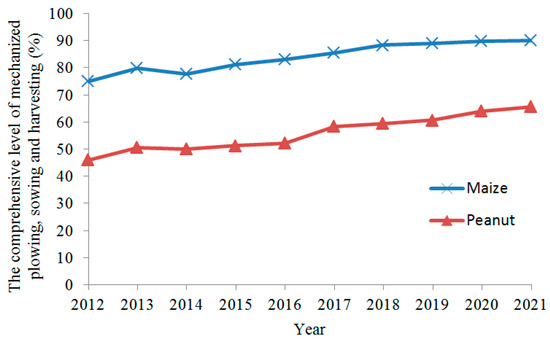
Figure 2.
Comprehensive rate of mechanized production for maize and peanut. Note: the data are obtained from The Yearbook of Agricultural Mechanization in China.
The main sowing seasons for maize and peanut in China is spring and early summer. Figure 3 shows the key links and operating machinery for maize and peanut production. Generally, only spring maize and spring peanuts require pre-sowing treatments, such as deep soil loosening, rotary tillage, and land leveling. At present, the whole process of plowing, sowing, field spraying, and harvesting in the main maize production areas has basically achieved mechanized operations. The plowing and land preparation process in peanut production has been basically mechanized. However, the mechanization level of the sowing and harvesting process of peanut is relatively low. Most peanuts require ridge planting. Even though, there are individual regions that have the habit of intercropping peanuts 10 to 15 days before the winter wheat harvest or sowing peanuts without tillage after wheat harvest. However, these planting methods have gradually been replaced by ridge planting in recent years due to their low yield, and proving to be time-consuming and laborious.
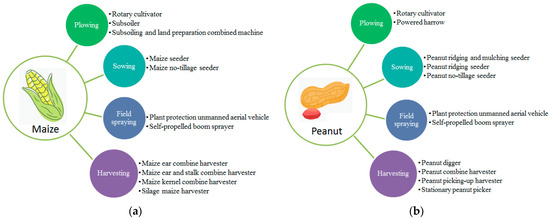
Figure 3.
Key links and machinery of maize and peanut production: (a) Maize; (b) Peanut.
There are currently two ways to harvest peanuts. One is to use a peanut combine harvester to complete digging, picking, and collecting simultaneously. This method has a high degree of technical integration, but requires high-peanut planting standards and farmland soil conditions. The other is a two-stage harvesting method. Firstly, peanuts need to be dug out and laid on the ground by a peanut digger, and dried for a certain period of time. Then, the peanut picking-up harvester is used to complete the operations of pick-up, picking, cleaning, and collecting simultaneously. It is also possible to manually collect the dried peanuts and transport them to the headland or other sites using a fixed fruit picker to complete peanut picking, cleaning, and collecting. Alternatively, it is also possible to manually collect the dried peanuts and transport them to a certain place in the field or other sites using a stationary peanut picker to complete picking, cleaning, and other operations.
2.2. Situation in Henan Province of China
Henan Province is located in the central part of China, which is a major agricultural province. Most of the province is in the warm temperate zone. This province is the largest peanut production province in China and one of the main maize production areas.
According to the China Statistical Yearbook data, the sown area and yield of peanut in Henan in 2021 were about 1.3 million hectares and 5.9 million tons, accounting for 27% and 32% of the national total, respectively. The sown area and yield of maize were about 3.9 million hectares and 20 million tons. They account for 9% and 8% of the national total, respectively. Because the proportion of plain basins in Henan Province exceeds 50%, its agricultural mechanization level ranks among the forefront in the country. In 2020, the comprehensive rate of mechanized production of crops in the province exceeded 85%, which was 14 percentage points higher than the national level. Among them, the comprehensive rate of the mechanized production of maize exceeded 92%, and the mechanization rate of peanut harvest exceeded 75%.
3. Analysis of Characteristics of Maize-Peanut Strip Intercropping
Intercropping maize and peanut is not a new agricultural technology, but it is a good technology to promote sustainable agricultural development. A large number of practices have proven that this intercropping of grasses and legumes has many advantages (as shown in Figure 4).
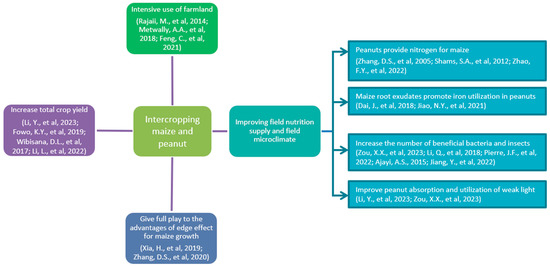
Figure 4.
Advantages of intercropping maize and peanut [2,3,5,15,20,23,24,25,26,27,28,29,30,31,32,33,34,35,36].
Maize-peanut strip intercropping is a new planting pattern suitable for mechanized production, which is innovative and developed on the basis of traditional intercropping. Its main goal is to increase peanut yield without reducing maize yield. This planting method has the following characteristics compared to traditional intercropping of maize and peanut.
- (1)
- The arrangement of rows of maize and peanut is different. The traditional intercropping model uses one row of maize intercropping with one row of peanuts, or multiple rows of maize intercropping with one row of peanuts. It has a significant impact on the shading of peanuts and is not conducive to mechanized operations. The strip intercropping uses maize planting belts and peanut planting belts for intercropping. By appropriately expanding the spacing between the two crop belts, the advantages of the edge effect for maize growth can be fully exploited. At the same time, the widths of the two planting belts are similar, which facilitates the realization of inter-annual crop rotation and mechanized production of maize and peanut.
- (2)
- The method of reducing the plant spacing is used to ensure the maize planting density. In traditional intercropping, the same number of peanut rows is often used to replace the same number of maize rows. The plant spacing of maize is also the same as that of monoculture. The total crop density of the two symbiotic maize and peanut is basically the same as that of monoculture, and the advantages of intercropping are not obvious. However, strip intercropping uses a method of reducing maize plant spacing to ensure that the planting density and yield of maize are comparable to monoculture.
4. Determination of Planting Pattern
Selecting the strip intercropping pattern needs to proceed from the perspective of deep integration of agricultural machinery and agronomy. At the same time, it should also be comprehensively determined based on local agricultural production conditions, maize and peanut monoculture planting patterns, and the current status of mechanized technology.
In terms of ecological and climatic conditions, Henan Province is mostly a plain basin. In the past 10 years, the average temperature range was from 12.9 °C to 16.5 °C, the annual average precipitation range was from 464.2 mm to 1193.2 mm, and the annual average sunshine hours range was from 1505.9 h to 2230.7 h. It is suitable for the growth of various crops.
In terms of the agronomic aspects of maize and peanut cultivation, the row spacing of maize in Henan Province is about 50 cm, and the spacing in the rows of peanut is about 25 cm. Peanuts are sown using rotary tillage and ridging. The ridge distance is 75 cm to 85 cm, the width of the ridge is about 50 cm, and the height of the ridge is about 15 cm.
For the mechanized production of maize and peanut, the whole process of the mechanized operation of maize in Henan Province has been basically achieved. The number of working rows of existing maize seeders ranges from 2 to 5, and is dominated by 3 or 4 rows. The maize harvester operates in a range of 2 to 4 rows, and is dominated by 4 rows. In recent years, with the land transfer and large-scale cultivation of peanuts, the level of the whole-process mechanized production of peanuts has also increased year by year. Peanut seeders have also been gradually developed from traditional one ridge (two rows) to two ridges (four rows) and three ridges (six rows). In the field of peanut harvesting, a two-stage machine harvesting mode has also basically formed, which combines mechanical digging with mechanical pick-up and pod picking.
One of the main differences between maize-peanut strip intercropping and traditional intercropping is to adapt to mechanized operations. Therefore, based on the current situation of maize and peanut cultivation and the mechanized production in Henan Province, and with reference to the wheel widths of tractors, maize harvesters, and peanut harvesters, we have studied and proposed a maize-peanut strip intercropping pattern for four rows of maize with two ridges of peanuts (hereinafter referred to as the 4-4 strip intercropping).
As shown in Figure 5, the total width of the 4-4 strip intercropping is 386 cm. Four rows of maize are used as a planting belt with a row spacing of 40 cm on both sides and a row spacing of 70 cm in the middle. This wide and narrow row configuration is conducive to the ventilation of the middle two rows of maize. Two rows of peanuts form a planting belt. The ridge height of peanuts is 15 cm. The ridge spacing is 80 cm, and the row spacing on the ridge is 28 cm, which is basically consistent with the peanut monoculture parameters. At this time, the width of the planting belts for the two crops is similar, which is conducive to the inter-annual rotation of maize and peanut, and can eliminate the obstacles to continuous peanut cultivation [37,38].

Figure 5.
Schematic diagram of 4-4 strip intercropping.
In order to give full play to the advantages of the edge effect for maize growth and adapt to the wheel track width of tractors, the distance between maize planting belts and peanut planting belts is determined to be 64 cm. In order to achieve the goal of reducing planting spacing and ensuring crop density, it is comprehensively considered to adjust the maize spacing from 25 cm under monoculture to 12 cm. At the same time, in order to ensure the coordinated growth of maize and peanut and achieve high yield, maize varieties should be selected with a compact plant type, density tolerance, and lodging resistance. Peanut varieties should be more shade tolerant, early maturing, and high yielding.
In order to further study the relationship between 4-4 strip intercropping and sole cropping, the planting density of maize and peanut was analyzed. The formula for calculating the proportion of peanut and maize plants under strip intercropping compared to sole cropping is shown in Equations (1) and (2), respectively.
where Cp is the proportion of peanut plants equivalent to sole cropping, %; Np is the number of peanut ridges, Np = 2; Dp is the ridge spacing for peanut planting, Dp = 80 cm; N is the total width of 4-4 strip intercropping, N = 386 cm.
where Cm is the proportion of maize plants equivalent to sole cropping, %; Nm is the number of maize rows, Nm = 4; Dm is the average row spacing for maize planting, Dm = 50 cm; d1 is the plant spacing of maize monoculture, d1 = 25 cm; d2 is the plant spacing of 4-4 strip intercropping, d2 = 12 cm.
By substituting the data into Equations (1) and (2), it is calculated that the proportion of peanut plants equivalent to sole cropping is about 42%, and the proportion of maize plants equivalent to sole cropping is about 108%. The calculation results show that this is an intercropping pattern with maize as the main crop and peanut as the auxiliary crop, which fully meets the requirements of stabilizing grain yield, increasing oil yield, and the coordinated development of grain and oil.
5. Screening of Agricultural Machineries
According to the needs of mechanized sowing, field spraying, and harvesting under the condition of 4-4 strip intercropping, the basic matching principle is to fully consider the current actual agricultural production conditions and the status of operating machinery [39]. In addition, it is preferred to appropriately modify existing machinery to adapt to the requirements of row spacing and plant spacing for strip intercropping, and improve the utilization rate of existing machinery.
5.1. Sowing
According to the actual production, maize in Henan Province is sown without tillage. Peanuts are sown using rotary tillage and ridging. There are two main sowing methods suitable for 4-4 strip intercropping: separate sowing and simultaneous sowing.
The so-called separate sowing is the use of a maize seeder and a peanut seeder for separate sowing. At present, the number of rows of maize seeders used in Henan Province is mostly three and four rows. The commonly used peanut seeder is two ridges. Therefore, it is possible to use a four-row maize seeder and a four-row peanut seeder to successively complete the sowing operation, thereby forming a 4-4 strip intercropping thereby.
The simultaneous seeding refers to the completion of the sowing operation through a dedicated maize and peanut integrated seeder. As shown in Figure 6, it is a typical maize and peanut integrated seeder. This type of machine adopts a combination configuration, in which two ridges of peanuts are sown by ridging in the middle and two rows of maize are sown by no-tillage on both sides. It needs to be used with tractors above 110.3 kW (150 horsepower). During sowing operations, adjustments must be made, such as the row spacing of maize to 40 cm, the plant spacing to 12 cm, the peanut ridge spacing to 80 cm, the row spacing on the ridge to 28 cm, the plant spacing to 15 cm to 18 cm.
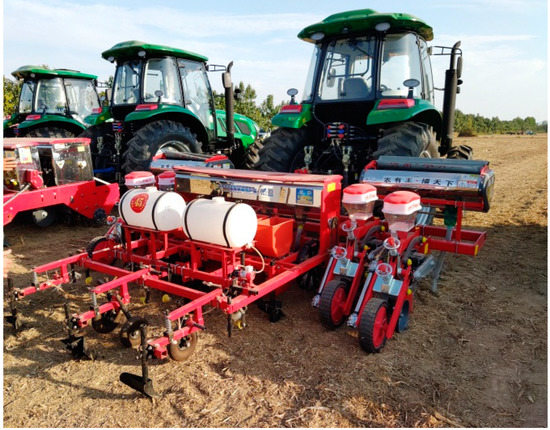
Figure 6.
A typical maize and peanut integrated seeder.
The operation routes for separate seeding and simultaneous seeding are shown in Figure 7. In order to further reduce the labor intensity of drivers and improve the accuracy of sowing operations and the uniformity of connecting rows, the Beidou intelligent monitoring terminal and auxiliary driving system can be installed on the tractor during operation. At the same time, in order to improve operational efficiency and reduce the number of times machinery enters the field and soil compacts, it is recommended to use a maize and peanut integrated seeder for sowing operations.
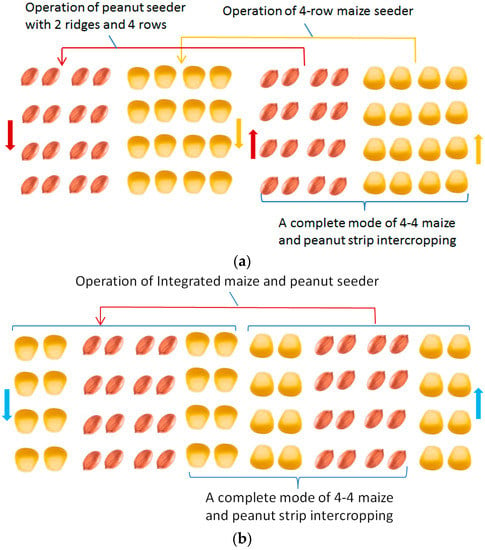
Figure 7.
Schematic diagram of 4-4 strip intercropping: (a) Separate operation of maize seeder and peanut seeder; Note: the orange arrow indicates the forward direction of the maize seeder, and the red indicates the forward direction of the peanut seeder. (b) Operation of integrated maize and peanut seeder. Note: the blue arrow indicates the forward direction of the maize and peanut integrated seeder.
5.2. Field Spraying
Field management mainly includes spraying, irrigation, weeding, etc. For irrigation, it currently and mainly relies on natural rainfall and sprinkler irrigation. The weed control of corn and peanuts in China mainly relies on spraying herbicides before or during sowing. Some weeding machines are mostly concentrated in the prototype development stage, and there have been no mature machines promoted and applied so far. The prevention and control of diseases, pests, and weeds during the growth of maize and peanuts is particularly important. At present, the commonly used self-propelled boom sprayer has the characteristics of uniform application and less drift of droplets. After installing an isolation device and transforming into a double spray system, it can be used for the field spraying of maize and peanut. This kind of machinery is usually equipped with a double spray system and a baffle that is perpendicular to the ground and parallel to the driving direction of the machine. By adjusting the positions of the spray head and baffles, it can be suitable for the strip intercropping requirements of maize and peanut with different planting widths.
5.3. Harvesting
The harvesting time and sequence of the two crops should be determined based on the variety and maturity of maize and peanut. Additionally, harvesting in due time to reduce losses. The harvest periods of maize and peanut in Henan Province are similar. Therefore, the maize harvester and the peanut harvester can be used for simultaneous harvesting one after the other.
The local conventional four-row maize harvester can meet the requirements of strip intercropping maize harvesting. The matching power of this type of machine is about 132.3 kW (180 horsepower). It can complete the combined harvesting of maize in four rows with a row spacing from 45 to 75 cm simultaneously (Figure 8).
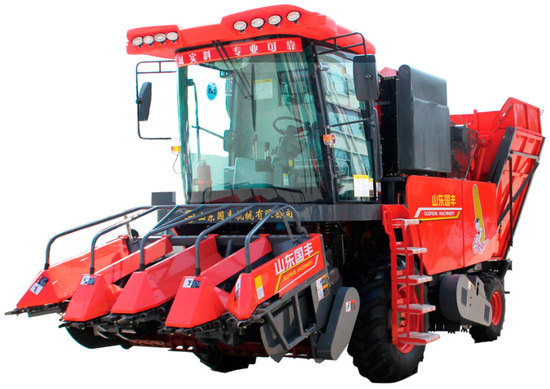
Figure 8.
Self-propelled four-row maize combine harvester. Copyright 2023, Shandong Guofeng Machinery Co., Ltd., Jining, China.
There are two methods of peanut harvesting: two-stage harvesting and combined harvesting. Two-stage harvesting begins with the use of a peanut digger to complete digging and soil cleaning. The peanut plants were dried in the field for 3 to 5 days to reduce the moisture content of the pods to less than 20%. Then, using the peanut picking-up harvester to complete the pick-up, pod picking, cleaning, and collecting. It is also possible to manually collect dried peanut plants and complete peanut picking, cleaning, and collecting through a stationary peanut picker. The main methods and processes of two-stage peanut harvesting are shown in Figure 9. The recommended machinery is shown in Figure 10.

Figure 9.
Two-stage peanut harvesting process.
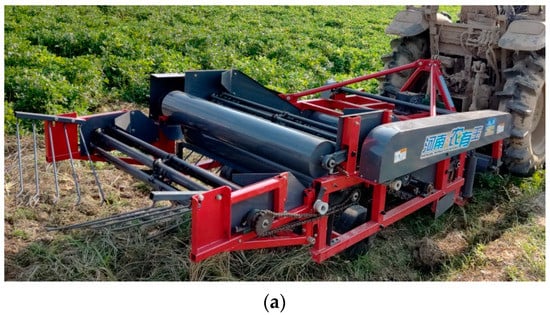

Figure 10.
Peanut harvesting machinery for two-stage harvesting: (a) Peanut digger with two ridges (four rows); (b) Peanut picking-up harvester; (c) Stationary peanut pod picker.
Figure 10a shows a typical peanut digger suitable for peanut harvesting in the Henan Province of China. It is suspended by a tractor and has a working width from 1400 to 1700 mm. It can complete the digging, soil cleaning, and laying of two ridges of peanuts simultaneously. Figure 10b shows a typical peanut picking-up harvester suitable for this area. This type of machine is tractor driven with a working width of about 1600 mm. It can complete the operations of pick-up, pod picking, cleaning, and collecting four rows of peanuts simultaneously. Figure 10c shows a typical stationary peanut pod picker suitable for this area. This type of machine is equipped with a working power of over 15 kW, and can complete peanut picking, cleaning, and collecting simultaneously. Its operating efficiency is ≥1500 kg/h. It can be moved to the work site by tractor traction according to work needs.
Although, it is possible to manually collect peanuts and transport them to a fixed site for pod picking. However, in order to improve operation efficiency and reduce labor intensity, it is recommended to use a peanut digger and a peanut picking-up harvester to work together. This can minimize the use of labor and improve the production efficiency of peanut mechanical harvesting.
Figure 11 shows a dedicated four-row peanut combine harvester. It is a self-propelled harvester that can complete the digging, soil cleaning, pod picking, and collecting of four rows of peanuts simultaneously.

Figure 11.
Peanut combine harvester.
6. Field Practice
6.1. Field Test Site and Process
To verify the adaptability and reliability of the determined 4-4 strip intercropping pattern and the selected operating machinery, in 2022, a field planting and harvesting experiment was conducted in Suiping County, Zhumadian City, Henan Province. The county has fertile soil and flat terrain, and is rich in wheat, maize, peanuts, tobacco and other crops.
The total area of the experimental field is about 10 hm2, and the soil type is sandy loam soil. The sowing time for 4-4 strip intercropping was 14 April 2022. The machinery used was a maize and peanut integrated seeder jointly developed by the Nanjing Institute of Agricultural Mechanization, Ministry of Agriculture and Rural Affairs, Nanjing, China and Henan Nongyuwang Agricultural Equipment Technology Co., Ltd., Zhumadian, China. The maize variety was Zhengdan 958. This maize variety has a compact plant type and is suitable for intercropping. The peanut variety was Yuanza 9307. This peanut variety is more shade tolerant and suitable for mechanized harvesting. The field sowing experiments and crop growth are shown in Figure 12.
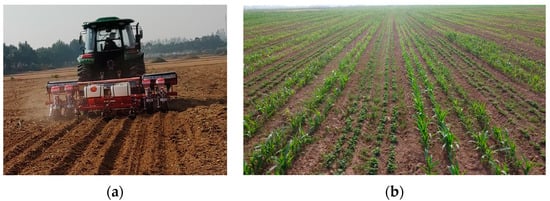
Figure 12.
Integrated sowing and field growth of maize and peanut: (a) Integrated seeder machine of maize and peanut; (b) Field growth of maize and peanut on 8 June 2022.
In the field spraying of maize and peanut, the self-propelled maize and peanut/soybean strip intercropping boom sprayer jointly developed by the Nanjing Institute of Agricultural Mechanization, Ministry of Agriculture and Rural Affairs and Yucheng City Yatai Machinery Manufacturing Co., Ltd. was used. As shown in Figure 13, this machine is equipped with an isolation device and a modified dual spraying system. It can meet the requirements for spraying herbicides, insecticides, and growth regulators in maize-peanut strip intercropping by adjusting the positions of the spray heads and baffles.
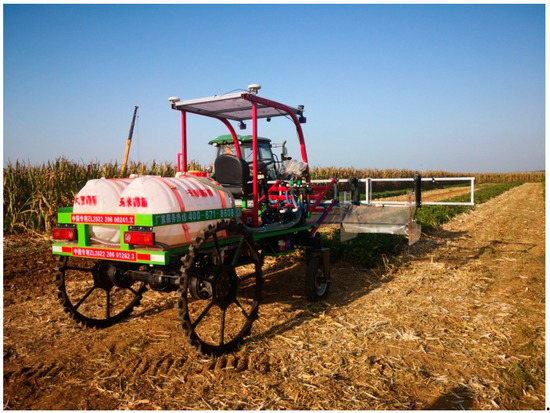
Figure 13.
Self-propelled boom sprayer.
The harvest time for maize and peanuts was 6 September 2022. Maize was a combined harvesting. Peanuts were two types of mechanical two-stage harvesting and mechanical combined harvesting.
Peanut two-stage harvesting used the 4HW-1500 peanut digger and the 4HQJ-1650 traction peanut picking-up harvester jointly developed by the Nanjing Institute of Agricultural Mechanization, Ministry of Agriculture and Rural Affairs and Henan Nongyuwang Agricultural Equipment Technology Co., Ltd. The peanut digger was connected to a 44.1 to 66.2 kW tractor with a working width of 1500 mm. It can complete the digging, soil cleaning, and laying of four rows of peanuts, and it meets the requirements for peanut harvesting under the condition of 4-4 strip intercropping. The peanut picking-up harvester was towed by a tractor above 58.8 kW and had a working width of 1650 mm. It can complete peanut pickup, picking, cleaning, and collecting simultaneously. The field peanut digger and picking operations under two-stage harvesting are shown in Figure 14.
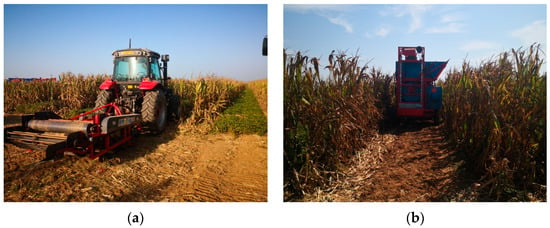
Figure 14.
Two-stage peanut harvesting in the field: (a) Peanut digging; (b) Peanut pick-up and picking.
The 4HLB-4 peanut combine harvester jointly developed by the Nanjing Institute of Agricultural Mechanization, Ministry of Agriculture and Rural Affairs and Linshu Dongtai Machinery Co., Ltd. is used for peanut combine harvesting. This machine is a crawler self-propelled type with a supporting power of 48 kW. It can complete the digging, clamping and conveying, picking, cleaning and other operations of four rows of peanuts simultaneously. The field harvest test is shown in Figure 15.
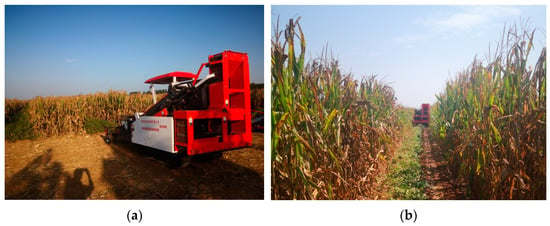
Figure 15.
Peanut combined harvesting in the field: (a) Peanut combined harvesting; (b) Status after harvest.
The TB90G self-propelled grain combine harvester produced by Zoomlion Heavy Industry Science & Technology Co., Ltd. (Shanghai, China) was used for maize harvesting. The matching power of this machine was 140 kW, which can meet the requirements of four-row maize combined harvesting under the 4-4 strip intercropping. The field harvest test is shown in Figure 16.
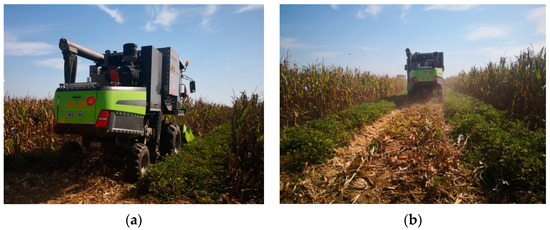
Figure 16.
Maize combined harvesting in the field: (a) Maize combined harvesting; (b) Status after harvest.
6.2. Yield Field Test Results
In order to further understand the crop yield under the condition of 4-4 strip intercropping, we conducted a comparative experiment with monocropping maize and monocropping peanut. The yield per mu (1/15 hm2) is shown in Table 1.

Table 1.
Yield per mu of maize and peanut under different cultivation methods.
The results presented in Table 1 prove that the yield of 4-4 strip intercropping is slightly lower than that of monocropping maize, but the yield of peanut per mu can be increased by 105.2 kg. This result meets the initial goal of achieving basically no reduction in maize yield and increasing some peanut yield. Additionally, the yield per mu of 4-4 strip intercropping is about 40% of that of monocropping peanut. In addition, compared to the 4-6 strip intercropping method proposed by Yanhong Li et al. [2], the yield of corn and peanut under the 4-4 strip intercropping method proposed in this study has increased. Its yield is considerable and plays an important role in alleviating the conflict between grain and oil competing for farmland.
7. Conclusions
Maize-peanut strip intercropping is an important way to solve the contradiction between grain and oil land competition in China, and achieve sustainable agricultural development. This method is an innovation in planting agronomy, which fully utilizes the nitrogen-fixation function of peanut nodules and the edge row advantage of maize. It can effectively ensure the maximization of the benefits of planting grain and oil, and is an effective means to ensure the stable production of grain crops and expand the planting of oil crops.
This study focuses on solving the bottlenecks of mechanized sowing, field spraying, and harvesting in the production of maize-peanut strip intercropping. The suitable planting pattern for strip intercropping of maize and peanut was determined, and a machine system for full mechanized production was formed. The results of field experiments showed that the determined 4-4 strip intercropping had a significant increase in yield compared to maize monoculture. The selected agricultural machinery has smooth operation and reliable performance, which can meet the mechanized production requirements of maize and peanut. The 4-4 strip intercropping and production machinery configuration scheme formed in this study have a strong guiding significance. Field experiments were conducted to further verify that the yield of 4-4 strip intercropping is slightly lower than that of monocropping maize, but the yield of peanut per mu can be increased by 105.2 kg. Moreover, the yield per mu of 4-4 strip intercropping is about 40% of that of monocropping peanut. These research results can effectively improve the standardization of maize-peanut strip intercropping and lay a solid foundation for the promotion of strip intercropping technology in Henan Province and surrounding areas.
Author Contributions
Conceptualization, methodology and supervision, H.Y., F.G. and Z.H.; validation, data curation and investigation, W.S., F.W. and H.X.; writing—original draft preparation and writing—review and editing, H.Y., W.S. and F.G.; project administration and funding acquisition, Z.H. All authors have read and agreed to the published version of the manuscript.
Funding
This research was funded by Major Scientific Research Tasks of the Agricultural Science and Technology Innovation Project of Chinese Academy of Agricultural Sciences, grant number CAAS-ZDRW202204; China Agricultural Research System, grant number CARS-13.
Institutional Review Board Statement
Not applicable.
Informed Consent Statement
Not applicable.
Data Availability Statement
Data will be made available on request.
Conflicts of Interest
The authors declare no conflict of interest.
References
- Chen, G.; Zhai, Y.; Zhou, J.; Li, Y.; Lin, J.; Wan, S.; Wu, Q. Optimizing maize belt width enhances productivity in wheat/maize intercropping systems. Sustainability 2022, 14, 16137. [Google Scholar]
- Li, Y.; Wang, L.; Zhao, B.; Liu, P.; Zhang, J.; Dong, S.; Shi, D. Crop productivity, economic advantage, and photosynthetic characteristics in a corn-peanut intercropping system. Agronomy 2023, 13, 509. [Google Scholar]
- Reddy, S.S.; Shivaraj, B.; Reddy, V.C.; Ananda, M.G. An efficient nutrient management system for a groundnut (Arachis hypogaea)-maize (Zea mays L.) cropping system in Karnataka, India. Trop. Agric. 2005, 82, 183–187. [Google Scholar]
- Subasinghe, S.; Senaratne, R. Below-ground competition in a maize/groundnut intercropping system as affected by the rooting soil layer. Plant Prod. Sci. 2000, 3, 108–111. [Google Scholar]
- Rajaii, M.; Dahmardeh, M. The evaluation of corn and peanut intercropping on efficiency of use the environmental resource and soil fertility. J. Agric. Sci. 2014, 6, 99–108. [Google Scholar]
- Karimuna, L.; Halim; Ansi, A.; Marfi, W.E.; Samaruddin, L. Yields of maize (Zea mays L.) and peanut (Arachis hypogaea L.) in intercropping system treated by bokashi plus fertilizer under early growth of teak plantation in Napabalano District, Muna Regency, Indonesia. IOP Conf. Ser. Earth Environ. Sci. 2020, 425, 012038. [Google Scholar]
- Awal, M.A.; Koshi, H.; Ikeda, T. Radiation interception and use by maize/peanut intercrop canopy. Agric. For. Meteorol. 2006, 139, 74–83. [Google Scholar]
- Kadir, M.; Rahman, J.; Riad, M.I.; Alam, M.K. Intercropping maize with groundnut in Char Land. Trop. Agrobiodivers. 2021, 2, 51–53. [Google Scholar]
- Inal, A.; Gunes, A.; Zhang, F.; Cakmak, I. Peanut/maize intercropping induced changes in rhizosphere and nutrient concentrations in shoots. Plant Physiol. Biochem. 2007, 45, 350–356. [Google Scholar]
- Mandimba, G.R.; Galandzou, C.; Guenguie, N. Effect of plant population densities on the growth of Zea mays L. and Arachis hypogaea L. in intercropping systems. Biol. Agric. Hortic. 1993, 10, 141–154. [Google Scholar]
- Kane, G.Q.; Fondo, S.; Oyekale, A.S. Efficiency of groundnuts/maize intercropped farms in Zoetele, South Cameroon: A data envelopement approach. Life Sci. J. 2012, 9, 3955–3962. [Google Scholar]
- Adjahossou, S.B.; Adjahossou, F.D.; Sinsin, B.; Boko, M.; Viera da Silva, J. Ecophysiological responses of peanut (Arachis hypogea) to shading due to maize (Zea mays) in intercropping systems. Cameroon J. Exp. Biol. 2008, 4, 29–39. [Google Scholar]
- Masuda, M.; Kaba, J.S.; Oforic, K.; Salifud, G. Relative planting dates effect on the agronomic performance of Maize (Zea mays L.) and Groundnut (Arachis hypogea L.) in an intercrop system. Am. Sci. Res. J. Eng. Technol. Sci. 2016, 16, 262–276. [Google Scholar]
- Godwin, A.A.; Moses, O.E. Bambara groundnut/maize intercropping: Effects of planting densities in Southern guinea savanna of Nigeria. Afr. J. Agric. Res. 2014, 9, 479–486. [Google Scholar]
- Metwally, A.A.; Safina, S.A.; Hefny, Y. Maximizing land equivalent ratio and economic return by intercropping maize with peanut under sandy soil in Egypt. Egypt. J. Agron. 2018, 40, 15–30. [Google Scholar]
- El-Koomy, M.; Attalla, R. Intercropping efficiency of two maize hybrids with peanut under sandy soils conditions. Arch. Agric. Sci. J. 2018, 1, 83–104. [Google Scholar]
- Natarajan, M.; Zharare, G.E. Intercropping groundnut with maize and sunflower for enhancing the productivity of groundnut-based cropping on light textured soils in Zimbabwe. Zimb. J. Agric. Res. 1994, 6, 181–186. [Google Scholar]
- Ward, A.L.; Rogers, D.J. Population ecology of Heteronyx piceus (Coleoptera: Scarabaeidae) in a peanut/maize cropping system. Bull. Entomol. Res. 2006, 96, 129–136. [Google Scholar]
- Surigaoge, S.; Yang, H.; Su, Y.; Du, Y.; Ren, S.; Fornara, D.; Christie, P.; Zhang, W.; Li, L. Maize/peanut intercropping has greater synergistic effects and home-field advantages than maize/soybean on straw decomposition. Front. Plant Sci. 2023, 14, 1100842. [Google Scholar]
- Zou, X.X.; Liu, Y.; Huang, M.M.; Li, F.; Si, T.; Wang, Y.F.; Yu, X.N.; Zhang, X.J.; Wang, H.X.; Shi, P.X. Rotational strip intercropping of maize and peanut enhances productivity by improving crop photosynthetic production and optimizing soil nutrients and bacterial communities. Field Crops Res. 2023, 291, 108770. [Google Scholar]
- Tang, H.; Xu, F.D.; Xu, C.S.; Zhao, J.L.; Wang, Y.J. The influence of a seed drop tube of the inside-filling air-blowing precision seed-metering device on seeding quality. Comput. Electron. Agric. 2023, 204, 107555. [Google Scholar]
- Tang, H.; Xu, C.S.; Wang, Z.M.; Wang, Q.; Wang, J.W. Optimized design, monitoring system development and experiment for a long-belt finger-clip precision corn seed metering device. Front. Plant Sci. 2022, 13, 814747. [Google Scholar]
- Fowo, K.Y.; Suminarti, N.E.; Suryanto, A. Response of three waxy corn (Zea mays L. Var. Ceratina Kulesh) varieties and various planting date of intercropped groundnut (Arachis hypogaea L.) in dry field. Int. J. Plant Biol. 2019, 10, 7459. [Google Scholar]
- Wibisana, D.L.; Budiyanto, G.; Widyastuti, T. The effect of intercropping system of corn (Zea mays L.) and peanut (Arachis hypogaea L.) on yield production in Ungaran. Planta Trop. J. Agro Sci. 2017, 5, 88–95. [Google Scholar]
- Li, L.; Zou, Y.; Wang, Y.; Chen, F.; Xing, G. Effects of corn intercropping with soybean/peanut/millet on the biomass and yield of corn under fertilizer reduction. Agriculture 2022, 12, 151. [Google Scholar]
- Feng, C.; Sun, Z.X.; Zhang, L.Z.; Feng, L.S.; Zheng, J.M.; Bai, W.; Gu, C.F.; Wang, Q.; Xu, Z.; Wopke, W.V.D. Maize/peanut intercropping increases land productivity: A meta-analysis. Field Crops Res. 2021, 270, 108208. [Google Scholar]
- Xia, H.; Wang, L.; Xue, Y.; Kong, W.; Xue, Y.; Yu, R.; Xu, H.; Wang, X.; Wang, J.; Liu, Z.; et al. Impact of increasing maize densities on agronomic performances and the community stability of productivity of maize/peanut intercropping systems. Agronomy 2019, 9, 150. [Google Scholar]
- Zhang, D.S.; Sun, Z.X.; Feng, L.S.; Bai, W.; Yang, N.; Zhang, Z.; Du, G.J.; Feng, C.; Cai, Q.; Wang, Q.; et al. Maize plant density affects yield, growth and source-sink relationship of crops in maize/peanut intercropping. Field Crops Res. 2020, 257, 107926. [Google Scholar]
- Shams, S.A.; Kamel, S.A.; Roshdy, A.; El-Dcbaby, S.A. Effect of maize plants distribution and nitrogen fertilization levels in peanut-maize intercrop. Egypt. J. Agron. 2012, 34, 39–52. [Google Scholar]
- Zhao, F.Y.; Sun, Z.X.; Feng, L.S.; Zhang, Y.Y.; Feng, C.; Bai, W.; Zheng, J.M.; Zhang, Z.; Yang, N.; Cai, Q.; et al. Biological N fixation but not mineral N fertilization enhances the accumulation of N in peanut soil in maize/peanut intercropping system. J. Agric. Food Res. 2022, 10, 100365. [Google Scholar]
- Dai, J.; Qiu, W.; Wang, N.; Nakanishi, H.; Zuo, Y. Comparative transcriptomic analysis of the roots of intercropped peanut and maize reveals novel insights into peanut iron nutrition. Plant Physiol. Biochem. 2018, 127, 516–524. [Google Scholar]
- Jiao, N.Y.; Wang, F.; Ma, C.; Zhang, F.S.; Steen, J.E. Interspecific interactions of iron and nitrogen use in peanut (Arachis hypogaea L.)-maize (Zea mays L.) intercropping on a calcareous soil. Eur. J. Agron. 2021, 128, 126303. [Google Scholar]
- Li, Q.; Chen, J.; Wu, L.; Luo, X.; Li, N.; Arafat, Y.; Lin, S.; Lin, W. Belowground interactions impact the soil bacterial community, soil fertility, and crop yield in maize/peanut intercropping Systems. Int. J. Mol. Sci. 2018, 19, 622. [Google Scholar]
- Pierre, J.F.; Latournerie-Moreno, L.; Garruña, R.; Jacobsen, K.L.; Laboski, C.A.M.; Us-Santamaría, R.; Ruiz-Sánchez, E. Effect of maize-legume intercropping on maize physio-agronomic parameters and beneficial insect abundance. Sustainability 2022, 14, 12385. [Google Scholar]
- Ajayi, A.S. The effects of tillage methods and intercropping on soil water characteristics, growth and grain yield of maize (Zea mays L.) and groundnut (Arachis hypogaea, L.) on an alfisol in South West, Nigeria. Afr. J. Agric. Res. 2015, 10, 2866–2874. [Google Scholar]
- Jiang, Y.; Khan, M.U.; Lin, X.; Lin, Z.; Lin, S.; Lin, W. Evaluation of maize/peanut intercropping effects on microbial assembly, root exudates and peanut nitrogen uptake. Plant Physiol. Biochem. 2022, 171, 75–83. [Google Scholar]
- Wang, R.N.; Sun, Z.X.; Zhang, L.Z.; Ning, Y.G.; Feng, L.S.; Wei, B.; Zhang, D.S.; Wang, Q.; Evers, J.B.; Liu, Y.; et al. Border-row proportion determines strength of interspecific interactions and crop yields in maize/peanut strip intercropping. Field Crops Res. 2020, 253, 107819. [Google Scholar]
- Han, F.; Guo, R.; Hussain, S.; Guo, S.Q.; Cai, T.; Zhang, P.; Jia, Z.K.; Naseer, M.A.; Saqib, M.; Chen, X.L.; et al. Rotation of planting strips and reduction in nitrogen fertilizer application can reduce nitrogen loss and optimize its balance in maize-peanut intercropping. Eur. J. Agron. 2023, 143, 126707. [Google Scholar]
- Tang, H.; Xu, C.S.; Xu, W.L.; Xu, Y.N.; Xiang, Y.S.; Wang, J.W. Method of straw ditch buried returning, development of supporting machine and analysis of influencing factor. Front. Plant Sci. 2022, 13, 967838. [Google Scholar]
Disclaimer/Publisher’s Note: The statements, opinions and data contained in all publications are solely those of the individual author(s) and contributor(s) and not of MDPI and/or the editor(s). MDPI and/or the editor(s) disclaim responsibility for any injury to people or property resulting from any ideas, methods, instructions or products referred to in the content. |
© 2023 by the authors. Licensee MDPI, Basel, Switzerland. This article is an open access article distributed under the terms and conditions of the Creative Commons Attribution (CC BY) license (https://creativecommons.org/licenses/by/4.0/).